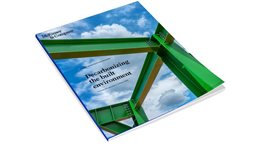The $11.6 trillion global infrastructure industry is hard at work constructing the buildings, structures, and assets that will house and transport generations to come. But many of the projects that make up the built environment—our buildings, water and electrical systems, roads and bridges, and transportation systems—are not being constructed in line with the world’s net-zero goals. According to McKinsey estimates, construction is directly or indirectly responsible for 40 percent of global CO2 emissions from fuel combustion and 25 percent of greenhouse-gas emissions overall.1
In this issue of Voices, leaders offer perspectives about how best to decarbonize our built environment and erect a sustainable future.
Moving the needle on net-zero emissions will be difficult. Our research shows that the world will need to invest $9.2 trillion each year until 2050 to achieve net-zero emissions in the built environment. Yet doing so will create a number of exciting opportunities around green-business building. With this in mind, McKinsey and the Global Infrastructure Investor Association (GIIA) discuss the pathways to decarbonization: understanding and mapping emissions sources across sectors, and describing how portfolio managers can provide the detail and transparency necessary to measure real progress against net-zero goals.

Voices on Infrastructure: Decarbonizing the built environment
Indeed, measuring progress, communicating it well, and predicting risk are all critical to success. Gordon Reid and Mark Williams from Scottish Water, Scotland’s national public water and wastewater service, share their insights on how achievable net-zero emissions goals are and how effective high-level strategy can be when it’s communicated properly. McKinsey’s Brodie Boland speaks to Ashurst’s Alex Guy about planning and delivering climate resilient capital projects. And Tariq Taherbhai of Aon grapples with the question of how to account for project risk effectively, from assessing the risks posed by suppliers and subcontractors to dealing with volatile climatic events in large construction projects.
Decarbonizing our built environment will also require the industry to embrace greener construction methods and materials. An article from McKinsey’s Zak Cutler, Taylor Dayton, Matthew Grant, Shu’aib Mahomed, and Jemilat Ojetayo offers a perspective on the importance of reducing embodied emissions—that is, the emissions associated with construction. And we share a summarized overview of a recent report on achieving net-zero emissions in the steel industry, written in collaboration by McKinsey and the Energy Transition Commission.
To round out the issue, the fifth and final article in the series by senior adviser Richard Westney and McKinsey’s Capital Excellence team illustrates how doing good demands doing better when it comes to delivering net-zero capital projects. In this case, doing better means establishing a new framework for procurement, engineering, and construction. The article also includes an interview with Greg Lawton, cofounder and CEO of project-delivery company Nodes & Links.
We hope you find this issue of Voices insightful as it relates to your own ongoing conversations about how to decarbonize buildings at every scale.
